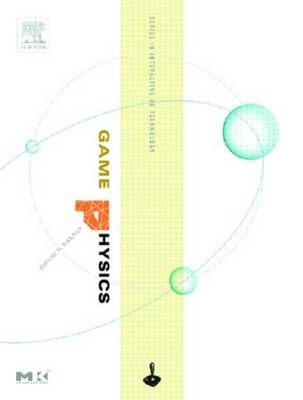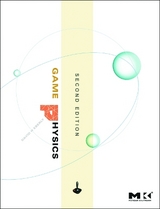
Game Physics
Morgan Kaufmann Publishers In (Verlag)
978-1-55860-740-8 (ISBN)
- Titel erscheint in neuer Auflage
- Artikel merken
Game Physics is an introduction to the ideas and techniques needed to create physically realistic 3D graphic environments. As a companion volume to Dave Eberly's industry standard 3D Game Engine Design, Game Physics shares a similar practical approach and format. Dave includes simulations to introduce the key problems involved and then gradually reveals the mathematical and physical concepts needed to solve them. He then describes all the algorithmic foundations and uses code examples and working source code to show how they are implemented, culminating in a large collection of physical simulations. This book tackles the complex, challenging issues that other books avoid, including Lagrangian dynamics, rigid body dynamics, impulse methods, resting contact, linear complementarity problems, deformable bodies, mass-spring systems, friction, numerical solution of differential equations, numerical stability and its relationship to physical stability, and Verlet integration methods. Dave even describes when real physics isn't necessary-and hacked physics will do.
Dave Eberly is the president of Geometric Tools, Inc. (www.geometrictools.com), a company that specializes in software development for computer graphics, image analysis, and numerical methods. Previously, he was the director of engineering at Numerical Design Ltd. (NDL), the company responsible for the real-time 3D game engine, NetImmerse. He also worked for NDL on Gamebryo, which was the next-generation engine after NetImmerse. His background includes a BA degree in mathematics from Bloomsburg University, MS and PhD degrees in mathematics from the University of Colorado at Boulder, and MS and PhD degrees in computer science from the University of North Carolina at ChapelHill. He is the author of 3D Game Engine Design, 2nd Edition (2006), 3D Game Engine Architecture (2005), Game Physics (2004), and coauthor with Philip Schneider of Geometric Tools for Computer Graphics (2003), all published by Morgan Kaufmann. As a mathematician, Dave did research in the mathematics of combustion, signal and image processing, and length-biased distributions in statistics. He was an associate professor at the University of Texas at San Antonio with an adjunct appointment in radiology at the U.T. Health Science Center at San Antonio. In 1991, he gave up his tenured position to re-train in computer science at the University of North Carolina. After graduating in 1994, he remained for one year as a research associate professor in computer science with a joint appointment in the Department of Neurosurgery, working in medical image analysis. His next stop was the SAS Institute, working for a year on SAS/Insight, a statistical graphics package. Finally, deciding that computer graphics and geometry were his real calling, Dave went to work for NDL (which is now Emergent Game Technologies), then to Magic Software, Inc., which later became Geometric Tools, Inc. Dave's participation in the newsgroup comp.graphics.algorit
Trademarks
Figures
Tables
Preface
About the CD-ROM
1 Introduction
1.1 A Brief History of the World
1.2 A Summary of the Topics
1.3 Examples and Exercises
2 Basic Concepts from Physics
2.1 Rigid Body Classification
2.2 Rigid Body Kinematics
2.2.1 Single Particle
2.2.2 Particle Systems and Continuous Materials
2.3 Newton's Laws
2.4 Forces
2.4.1 Gravitational Forces
2.4.2 Spring Forces
2.4.3 Friction and Other Dissipative Forces
2.4.4 Torque
2.4.5 Equilibrium
2.5 Momenta
2.5.1 Linear Momentum
2.5.2 Angular Momentum
2.5.3 Center of Mass
2.5.4 Moments and Products of Inertia
2.5.5 Mass and Inertia Tensor of a Solid Polyhedron
2.6 Energy
2.6.1 Work and Kinetic Energy
2.6.2 Conservative Forces and Potential Energy
3 Rigid Body Motion
3.1 Newtonian Dynamics
3.2 Lagrangian Dynamics
3.2.1 Equations of Motion for a Particle
3.2.2 Time-Varying Frames or Constraints
3.2.3 Interpretation of the Equations of Motion
3.2.4 Equations of Motion for a System of Particles
3.2.5 Equations of Motion for a Continuum of Mass
3.2.6 Examples with Conservative Forces
3.2.7 Examples with Dissipative Forces
3.3 Euler's Equations of Motion
4 Deformable Bodies
4.1 Elasticity, Stress, and Strain
4.2 Mass-Spring Systems
4.2.1 One-Dimensional Array of Masses
4.2.2 Two-Dimensional Array of Masses
4.2.3 Three-Dimensional Array of Masses
4.2.4 Arbitrary Configurations
4.3 Control Point Deformation
4.3.1 B-Spline Curves
4.3.2 NURBS Curves
4.3.3 B-Spline Surfaces
4.3.4 NURBS Surfaces
4.3.5 Surfaces Built from Curves
4.4 Free-Form Deformation
4.5 Implicit Surface Deformation
4.5.1 Level Set Extraction
4.5.2 Isocurve Extraction in 2D Images
4.5.3 Isosurface Extraction in 3D Images
5 Physics Engines
5.1 Unconstrained Motion
5.1.1 An Illustrative Implementation
5.1.2 A Practical Implementation
5.2 Constrained Motion
5.2.1 Collision Points
5.2.2 Collision Response for Colliding Contact
5.2.3 Collision Response for Resting Contact
5.2.4 An Illustrative Implementation
5.2.5 Lagrangian Dynamics
5.3 Collision Detection with Convex Polyhedra
5.3.1 The Method of Separating Axes
5.3.2 Stationary Objects
5.3.3 Objects Moving with Constant Linear Velocity
5.3.4 Oriented Bounding Boxes
5.3.5 Boxes Moving with Constant Linear and Angular Velocity
5.4 Collision Culling: Spatial and Temporal Coherence
5.4.1 Culling with Bounding Spheres
5.4.2 Culling with Axis-Aligned Bounding Boxes
5.5 Variations
6 Physics and Shader Programs
6.1 Introduction
6.2 Vertex and Pixel Shaders
6.3 Deformation by Vertex Displacement
6.4 Skin-and-Bones Animation
6.5 Rippling Ocean Waves
6.6 Refraction
6.7 Fresnel Reflectance
6.8 Iridescence
7 Linear Complementarity and Mathematical Programming
7.1 Linear Programming
7.1.1 A Two-Dimensional Example
7.1.2 Solution by Pairwise Intersections
7.1.3 Statement of the General Problem
7.1.4 The Dual Problem
7.2 The Linear Complementarity Problem
7.2.1 The Lemke-Howson Algorithm
7.2.2 Zero Constant Terms
7.2.3 The Complementary Variable Cannot Leave the Diction
7.3 Mathematical Programming
7.3.1 Karush-Kuhn-Tucker Conditions
7.3.2 Convex Quadratic Programming
7.3.3 General Duality Theory
7.4 Applications
7.4.1 Distance Calculations
7.4.2 Contact Forces
8 Differential Equations
8.1 First-Order Equations
8.2 Existence, Uniqueness, and Continuous Dependence
8.3 Second-Order Equations
8.4 General-Order Differential Equations
8.5 Systems of Linear Differential Equations
8.6 Equilibria and Stability
8.6.1 Stability for Constant-Coefficient Linear Systems
8.6.2 Stability for General Autonomous Systems
9 Numerical Methods
9.1 Euler's Method
9.2 Higher-Order Taylor Methods
9.3 Methods Via an Integral Formulation
9.4 Runge-Kutta Methods
9.4.1 Second-Order Methods
9.4.2 Third-Order Methods
9.4.3 Fourth-Order Method
9.5 Multistep Methods
9.6 Predictor-Corrector Methods
9.7 Extrapolation Methods
9.7.1 Richardson Extrapolation
9.7.2 Application to Differential Equations
9.7.3 Polynomial Interpolation and Extrapolation
9.7.4 Rational Polynomial Interpolation and Extrapolation
9.7.5 Modified Midpoint Method
9.7.6 Bulirsch-Stoer Method
9.8 Verlet Integration
9.8.1 Forces without a Velocity Component
9.8.2 Forces with a Velocity Component
9.8.3 Simulating Drag in the System
9.8.4 Leap Frog Method
9.8.5 Velocity Verlet Method
9.8.6 Gear's Fifth-Order Predictor-Corrector Method
9.9 Numerical Stability and its Relationship to Physical Stability
9.9.1 Stability for Single-Step Methods
9.9.2 Stability for Multistep Methods
9.9.3 Choosing a Stable Step Size
9.10 Stiff Equations
10 Quaternions
10.1 Rotation Matrices
10.2 The Classical Approach
10.2.1 Algebraic Operations
10.2.2 Relationship of Quaternions to Rotations
10.3 A Linear Algebraic Approach
10.4 From Rotation Matrices to Quaternions
Contributed by Ken Shoemake
10.4.1 2D Rotations
10.4.2 Linearity
10.4.3 3D Rotations: Geometry
10.4.4 4D Rotations
10.4.5 3D Rotations: Algebra
10.4.6 4D Matrix
10.4.7 Retrospect, Prospect
10.5 Interpolation of Quaternions
10.5.1 Spherical Linear Interpolation
10.5.2 Spherical Quadratic Interpolation
10.6 Derivatives of Time-Varying Quaternions
A Linear Algebra
A.1 A Review of Number Systems
A.1.1 The Integers
A.1.2 The Rational Numbers
A.1.3 The Real Numbers
A.1.4 The Complex Numbers
A.1.5 Fields
A.2 Systems of Linear Equations
A.2.1 A Closer Look at Two Equations in Two Unknowns
A.2.2 Gaussian Elimination and Elementary Row Operations
A.2.3 Nonsquare Systems of Equations
A.2.4 The Geometry of Linear Systems
A.2.5 Numerical Issues
A.2.6 Iterative Methods for Solving Linear Systems
A.3 Matrices
A.3.1 Some Special Matrices
A.3.2 Elementary Row Matrices
A.3.3 Inverse Matrices
A.3.4 Properties of Inverses
A.3.5 Construction of Inverses
A.3.6 LU Decomposition
A.4 Vector Spaces
A.4.1 Definition of a Vector Space
A.4.2 Linear Combinations, Spans, and Subspaces
A.4.3 Linear Independence and Bases
A.4.4 Inner Products, Length, Orthogonality, and Projection
A.4.5 Dot Product, Cross Product, and Triple Products
A.4.6 Orthogonal Subspaces
A.4.7 The Fundamental Theorem of Linear Algebra
A.4.8 Projection and Least Squares
A.4.9 Linear Transformations
A.5 Advanced Topics
A.5.1 Determinants
A.5.2 Eigenvalues and Eigenvectors
A.5.3 Eigendecomposition for Symmetric Matrices
A.5.4 S + N Decomposition
A.5.5 Applications
B Affine Algebra
B.1 Introduction
B.2 Coordinate Systems
B.3 Subspaces
B.4 Transformations
B.5 Barycentric Coordinates
B.5.1 Triangles
B.5.2 Tetrahedra
B.5.3 Simplices
B.5.4 Length, Area, Volume, and Hypervolume
C Calculus
C.1 Univariate Calculus
C.1.1 Limits
C.1.2 Limits of a Sequence
C.1.3 Continuity
C.1.4 Differentiation
C.1.5 L'Hôpital's Rule
C.1.6 Integration
C.2 Multivariate Calculus
C.2.1 Limits and Continuity
C.2.2 Differentiation
C.2.3 Integration
C.3 Applications
C.3.1 Optimization
C.3.2 Constrained Optimization
C.3.3 Derivative Approximations by Finite Differences
D Ordinary Difference Equations
D.1 Definitions
D.2 Linear Equations
D.2.1 First-Order Linear Equations
D.2.2 Second-Order Linear Equations
D.3 Constant Coefficient Equations
D.4 Systems of Equations
Bibliography
Index
| Erscheint lt. Verlag | 24.12.2003 |
|---|---|
| Verlagsort | San Francisco |
| Sprache | englisch |
| Maße | 190 x 234 mm |
| Gewicht | 1678 g |
| Themenwelt | Mathematik / Informatik ► Informatik ► Grafik / Design |
| Informatik ► Weitere Themen ► Computerspiele | |
| ISBN-10 | 1-55860-740-4 / 1558607404 |
| ISBN-13 | 978-1-55860-740-8 / 9781558607408 |
| Zustand | Neuware |
| Haben Sie eine Frage zum Produkt? |
aus dem Bereich



